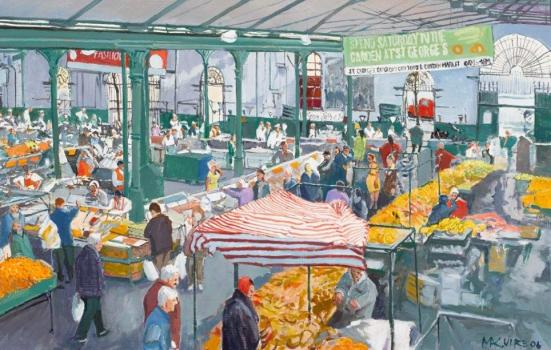A digital gallery, loan schemes and public tours in schools and libraries are among the proposals for opening the Civil Service Art Collection to all.

'St George's Market', courtesy of NI Civil Service Art Collection
Northern Ireland’s Civil Service Art Collection is to be made more accessible to the public and brought into community spaces, including schools and libraries, Finance Minister Máirtín Ó Muilleoir announced this week.
“I am committed to ensuring the art is promoted as a living collection to the widest possible audience,” he said. “This initiative recognises the historic and cultural importance of the Civil Service collection which should be available to be seen by the people, who have after all, paid for it.”
Recommendations on how best to use the 1,400 works within the collection have been included in a report by the newly formed Arts Advisory Panel. It makes a number of recommendations for opening up the collection to both staff and the public, including students and young people, such as a programme of art procurement and an ongoing series of exhibitions.
The Minister said: “I want to help support our art community particularly if I can nurture young artists and help them to become established through this programme of commissioning.”
The announcement was made at the opening of ‘Interesting and Weird at the Same Time’, a joint touring exhibition by the Department of Finance and the Office of Public Works, held in The Alley Theatre, Strabane. The exhibits were chosen by primary school pupils and the exhibition’s title was a child’s description of one of the works.
Chief Executive of the Arts Council of Northern Ireland Roísín McDonough, who chairs the Art Advisory Panel, said: “I can say resolutely this is one of Northern Ireland’s most important collections containing many significant works by our leading artists.”
“Whether building digital gallery space for the collection through a website, supporting a procurement and commissioning programme for the work of emerging artists, or developing loan schemes and public tours, this collection must be curated and displayed appropriately and celebrated for its gorgeous and challenging content,” she added.




